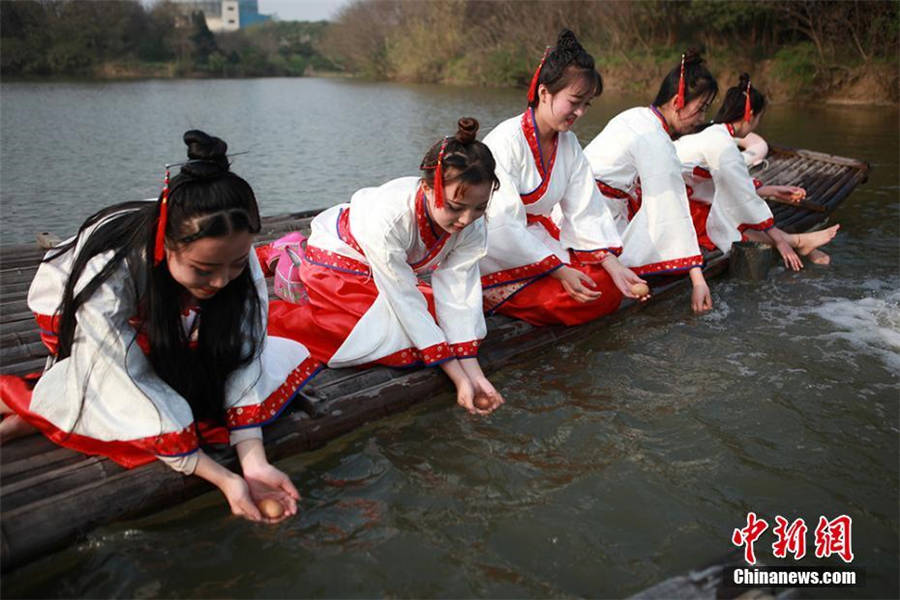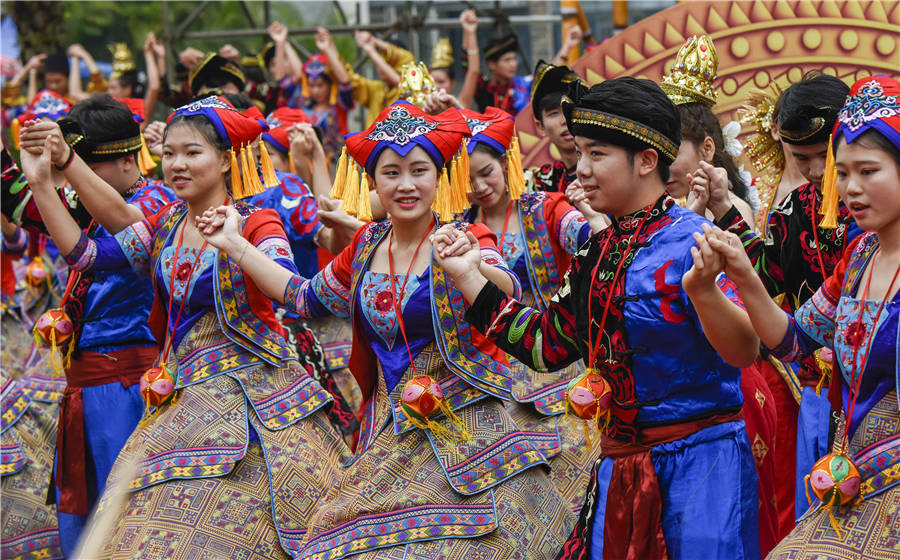Culture Insider: Shangsi Festival
Shangsi Festival, also known as the Double Third Festival, is an ancient Chinese festival celebrated on the third day of the third lunar month, which falls on April 14 this year.
It is a festival mainly observed by Chinese ethnic groups, including Han and Zhuang, to ward off evil spirits and natural disasters.
The Shangsi Festival is also a day considered to be the possible birthday of the Yellow Emperor. A well-known phrase goes, "San yue san, Xuan Yuan sheng", meaning, "On the third day of the third month, the Xuan Yuan (Yellow Emperor) was born."
In 2018, the Communist Youth League's Central Committee set the third day of the third lunar month as China Huafu Day (Chinese National Costume Day), as a way to advocate the beauty of traditional Chinese clothes. The first event was celebrated on April 18 that year in Xi'an.

Women wearing traditional Chinese costumes participate in the ancient custom of drifting eggs at Changzhou, Jiangsu province on March 29, 2018. [Photo/Chinanews.com]
Origin of the festival
There are many theories about the festival's true origins. Some say it stems from a dinner party held on the banks of the Qushui River during the Zhou Dynasty (1100 - 221 BC). Others say it comes from the custom of getting rid of evil by bathing in the river. On this day, people would hold a sacrificial ceremony by the riverside to honor their ancestors, then bathe in the river with herbs to cleanse and purify their bodies. Following that, young men and women would go for a spring outing – these scenes were described in the ancient text, Shi Jing (The Book of Songs).
Shangsi Festival activities have changed with the times. The feast and praying for descendants by the river were added in the Han Dynasty (206 BC - AD 220). It was after the Wei and Jin dynasties (AD 220 - 420) that the event developed into the Double Third Day, fixed on the third day of the third lunar month.
The calligrapher Wang Xizhi from the Eastern Jin Dynasty (AD 317 - 420) wrote in his Lanting Xu (Preface to the Poems Composed at the Orchid Pavilion) about how literary men took a bath and composed poetry while drinking from cups left adrift and bobbing along the winding river.
In the Tang Dynasty (AD 618 - 907), it is said the emperor would treat his followers beside the river, along with ordinary people enjoying drinks and sightseeing. People in the Chang'an area would also watch cricket-fighting.
After the Ming and Qing dynasties (AD 1368 - 1911), the ritual activities were gradually omitted, and the festival developed into a spring outing featuring lively activities like drifting cups, drifting eggs, drifting dates, stone throwing, wearing willow-wreaths, hiking and eating glutinous rice and listening to choir music.
As Shangsi Festival happens so close to Qingming Festival, many young people today only know about the latter.

Singing and dancing performances are staged to celebrate Double Third Festival in Nanning city, Guangxi Zhang autonomous region, on March 30, 2017. [Photo/IC]
Customs of the festival
It's a traditional Han festival, as well as an occasion for many of the minority nationalities in China. People once held celebrations across the country.
During the festival, Han people would go for outings, enjoy flowers in the fields and dates with their lovers. It is also a day used for cleansing rituals to prevent disease and getting rid of bad luck.
To the Zhuang ethnic group in Southwest China's Guangxi Zhuang autonomous region, March 3 is a festival for young people to sing songs and find their true love. Since 1983, singing festivals have been held annually on this day throughout Guangxi.
There is a folk tale about singing traditions in ancient China, where a renowned singer's daughter chose her husband by holding a singing competition and found her true love. Since then, hunting for lovers by singing has become a tradition.
Bamboo dancing is another essential activity for the Zhuang people on March 3 on the lunar calendar. Teenagers and adults dress in festive costumes while beating drums and expressing their admiration for each other.
In the southern Chinese island province of Hainan, the Li and Miao people celebrate the special day as the "Festival of Love", along with it being a day for remembering ancestors.
The She, Dong, Yao and Tujia ethnic groups also have a tradition of celebrating on the third day of the third lunar month.
Traditional food
Five-colored sticky rice and painted eggs are traditional food for the Shangsi Festival. The Zhuang people believe rice is good for health and painted eggs are seen as a symbol of love.
People will make five-colored sticky rice cake, which can be eaten directly after steaming or made into fried rice. It is made by using various natural colorings, such as buffalo grass, which has bright colors and stimulates the appetite.
